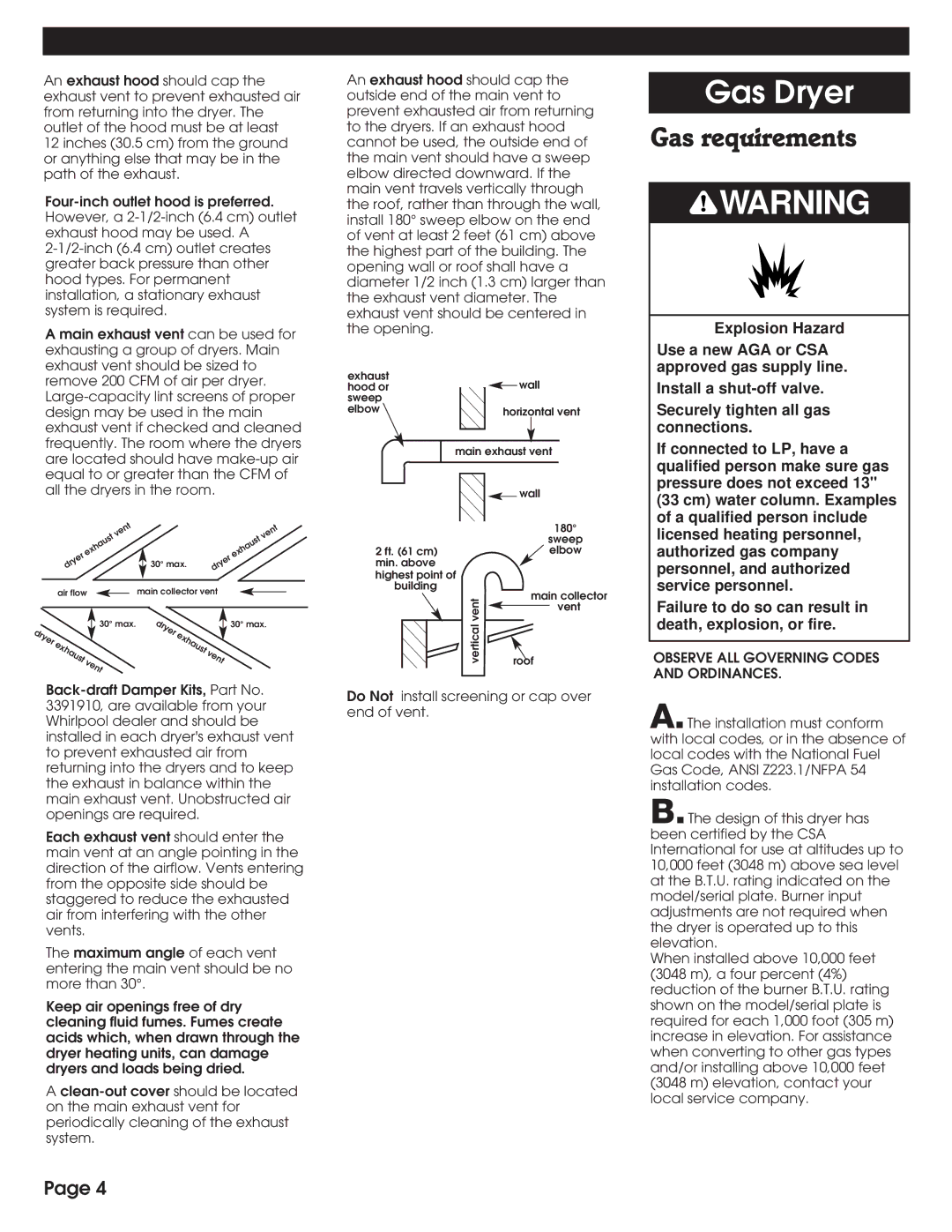
An exhaust hood should cap the exhaust vent to prevent exhausted air from returning into the dryer. The outlet of the hood must be at least
12 inches (30.5 cm) from the ground or anything else that may be in the path of the exhaust.
A main exhaust vent can be used for exhausting a group of dryers. Main exhaust vent should be sized to remove 200 CFM of air per dryer.
| exhaust | vent |
|
|
| exhaust | vent | |||
dryer |
|
|
| 30° max. | dryer |
| ||||
|
|
|
|
|
|
|
| |||
|
|
|
|
|
|
|
| |||
|
|
|
|
|
|
|
|
|
| |
air flow |
|
|
| main collector vent |
|
|
| |||
|
|
|
|
|
| |||||
dryer |
|
| 30° max. | dryer |
|
| 30° max. |
exhaust |
|
|
| exhaust |
|
| |
|
|
|
| vent | |||
| vent |
|
| ||||
|
|
|
|
|
| ||
Each exhaust vent should enter the main vent at an angle pointing in the direction of the airflow. Vents entering from the opposite side should be staggered to reduce the exhausted air from interfering with the other vents.
The maximum angle of each vent entering the main vent should be no more than 30°.
Keep air openings free of dry cleaning fluid fumes. Fumes create acids which, when drawn through the dryer heating units, can damage dryers and loads being dried.
A
An exhaust hood should cap the outside end of the main vent to prevent exhausted air from returning to the dryers. If an exhaust hood cannot be used, the outside end of the main vent should have a sweep elbow directed downward. If the main vent travels vertically through the roof, rather than through the wall, install 180° sweep elbow on the end of vent at least 2 feet (61 cm) above the highest part of the building. The opening wall or roof shall have a diameter 1/2 inch (1.3 cm) larger than the exhaust vent diameter. The exhaust vent should be centered in the opening.
exhaust |
|
|
| wall | ||
hood or |
|
|
|
| ||
|
|
|
| |||
sweep |
|
|
|
|
| |
elbow |
|
| horizontal vent | |||
|
|
|
|
|
|
|
main exhaust vent
![]() wall
wall
180°
sweep
2 ft. (61 cm)elbow min. above
highest point of
building
ventvertical |
| main collector | |
|
| vent | |
|
|
| |
|
|
|
|
| roof | ||
Do Not install screening or cap over end of vent.
Gas Dryer
Gas requirements
![]() WARNING
WARNING
Explosion Hazard
Use a new AGA or CSA approved gas supply line.
Install a
Securely tighten all gas connections.
If connected to LP, have a qualified person make sure gas pressure does not exceed 13" (33 cm) water column. Examples of a qualified person include licensed heating personnel, authorized gas company personnel, and authorized service personnel.
Failure to do so can result in death, explosion, or fire.
OBSERVE ALL GOVERNING CODES AND ORDINANCES.
A.The installation must conform with local codes, or in the absence of local codes with the National Fuel Gas Code, ANSI Z223.1/NFPA 54 installation codes.
B.The design of this dryer has been certified by the CSA International for use at altitudes up to 10,000 feet (3048 m) above sea level at the B.T.U. rating indicated on the model/serial plate. Burner input adjustments are not required when the dryer is operated up to this elevation.
When installed above 10,000 feet (3048 m), a four percent (4%) reduction of the burner B.T.U. rating shown on the model/serial plate is required for each 1,000 foot (305 m) increase in elevation. For assistance when converting to other gas types and/or installing above 10,000 feet (3048 m) elevation, contact your local service company.
Page 4
